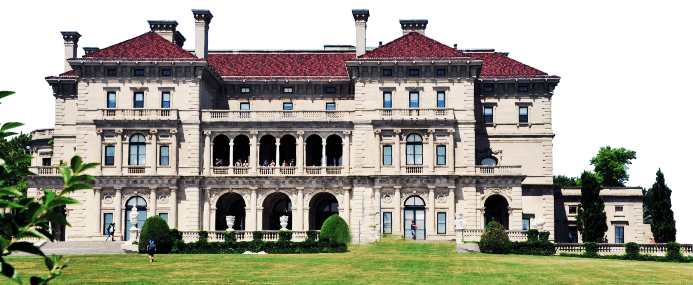
The nautical and gilded-age town of Newport, RI, is an easy three-and-a-half hour drive on I-95 for most residents of Nassau County. For a weekend away, Newport offers many things to do along with plenty of good restaurants. We recently spent two fun nights near the center of it all at the Newport Marina and Hotel and could not have had a better visit.
Newport was founded in 1639 as a place of religious freedom and immediately became a center of commerce from the mid-1600s. It is rich in colonial history, and its architecture shows when strolling by the many homes dating back to the colonial and post-colonial time. In fact, Newport claims to have the highest number of surviving colonial buildings of any city in the United States. Its dark history includes being an important part of the “triangle trade” that bought and sold slaves, sugar and rum. During that time, many slaves were traded here, and the city had 22 rum stills. Among other things, piracy was practiced here in its early days, and during Prohibition there was much rum-running because of all the hidden little coves in the area.
After settling down, we walked three blocks north to the Newport Discovery Center. This place should be your first stop, as everything you need to see and do can be explained at the information booth and many attraction tickets can be purchased here.
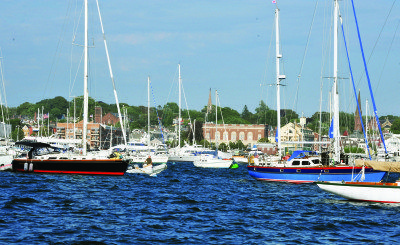
At the discovery center, we boarded the Newport Travel Tours trolley to get acclimated to the city. We picked this company because the open windows on the trolley allowed better viewing and photos. This tour took us all around Newport and out on the scenic 10-mile drive. Here, we viewed the 28-room Hammersmith Farm mansion that President and Jackie Kennedy were married in.
During our tour, the driver frequently stopped to tell us the history of what we were seeing. He also discussed some of the prominent families of the area, as well as their clubs where only the “right” names could become members. On Bellevue Avenue, we made short stops at a few of the cottages for a quick look or to let passengers off. Our guide ended the nearly two-hour tour passing the historical section.
Arriving back from the tour, we strolled Bowen’s Wharf next to our dock bustling with people going in and out of the shops and restaurants. After a snack here, we walked over to Sayer’s Wharf to catch the sunset sail with 12 Meters Charters. Here we boarded a 1970 America’s Cup-style race boat named the Heritage. Guests on board can help raise the sails and take turns at the wheel. Seating on board is basic. The idea here is to experience a race boat. (For those who want a more mellow experience on the water, Classic Cruises of Newport offers tours all day on an old rumrunner or a classic schooner.) Our sail was an exhilarating experience, giving us a small taste of what a race boat feels like.
Coming back to the bay, our captain raced and beat another 12-meter boat to the entrance. Dinner that night was at the Speakeasy on America’s Cup Avenue, where there were plenty of good choices for my non-seafood dining wife. We found the food there very good and reasonably priced with a lively atmosphere.
Our next day had us on a full schedule starting out on the R67 bus for $2 from the discovery center to the Breakers mansion. We picked this stop because it let us off on the Cliff Walk. Cliff Walk has been said to be one top 100 walks in the United States. It is designated a National Recreational Trail in a National Historic District.
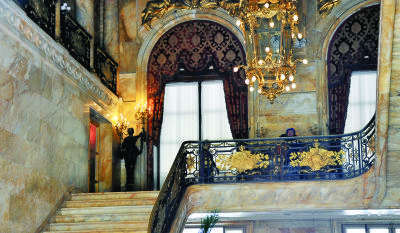
If you start at the beginning, Cliff Walk is 3.5 miles one way, but starting at the Breakers shaves off a mile. The trail goes along the water’s edge which is behind all the mansions of the area. This puts you directly between the end of their backyard and the ocean. The trail is nearly flat and relatively easy to walk on with the exception of some areas near the end that have you walk on rocks that are uneven.
Cliff Walk ends on Bellevue Avenue. From here we walked back toward the Breakers, stopping at three cottages. The first one was called Rough Point, last owned by Doris Duke (as in Duke University and the Doris Duke Foundation). This 39,000-square foot Tudor-style house was completed in 1892 for Fredrick Vanderbilt and is one of the more moderate “cottages” we visited.
The Duke family bought the house in 1922 and it is known locally as the Doris Duke House because she inherited it. Here a tour guide gives you a history of the family and then takes you through the house that is filled with Duke’s furniture and personal effects. This house also has some modern art displayed and for sale. It ends with a brief film on her and life and charities.
Marble House was our next stop. It was completed in 1892 for Mr. and Mrs. William K. Vanderbilt and designed by Richard Hunt to look like the Petit Trianon at Versailles. The cost of the house was reported at $11 million, of which $7 million was spent on 500,000 cubic feet of marble. This would be the equivalent of more than $270 million in today’s dollars. Part of the cost included the intricate hand designs on all the ceilings.
Upon its completion, Vanderbilt gave the house to his wife as a 39th birthday present. It has 50 rooms and a staff of 36 to run it. Marble House was important to Newport because it was the first cottage to transform Newport from less formal wooden structures to the legendary over-the-top stone palaces. The grounds have a Chinese tea house on the water’s edge above the Cliff Walk.
Walking further down the street we visited The Breakers which is the grandest of the cottages.
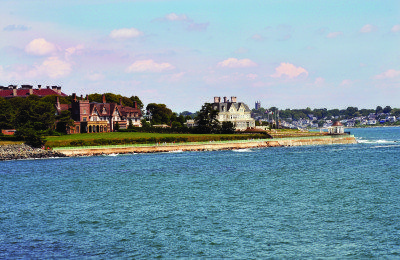
In 1895 Cornelius Vanderbilt II became Chairman and President of the New York Central Railroad and purchased a wooden house called The Breakers in Newport. After the house burned down he also commissioned Hunt to design a 70-room Italian Renaissance-style palazzo inspired by the 16th-century palaces of Genoa and Turin. This house is 125,339-square feet and looks palatial when walking up to it. Gladys, their daughter, inherited The Breakers on her mother’s death in 1934.
As a supporter of The Preservation Society of Newport County, she opened The Breakers in 1948 to raise funds for the Society. In 1972, the Preservation Society purchased the house from her heirs with the condition that members of the Vanderbilt family can use the third floor when they wish. The style, room count and what the house offered for the summer season was an amazing show of wealth.
Tours of both Marble House and the Breakers are done by hand-held audio player and take about 45 minutes to one hour depending on how detailed you wish to get. In both audio guides there were clips of life by the family or servants. All three tours talked about the life and times of the Gilded-Age and made it clear that money was to be shown and flaunted.
That meant to see and be seen. It was said that women would change up to seven times a day to show the latest fashions. Men would occupy their days with sailing, golf or other sports. Lavish dinners were also a must to throw or get an invitation to. It was here that marriage-age children would also be decided on because “marrying up” or to the right family was considered very important.
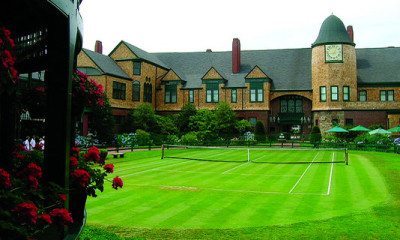
After our three cottages we hopped on the R67 for the ride back to town. We stopped for a quick view of the grass tennis courts at the Tennis Hall of Fame before walking on Thames Street to do a little shopping. Dinner that night was near the marina at The Landing, where we dined outdoors on panko-coated fish and chips, stuffed clams, Portuguese stew and fried whole belly clams. For nighttime entertainment, boaters can usually find music at one of the clubs near the docks.
For our last morning we decided to stroll around the historic district, visit the Touro Synagogue and take a historical walking tour of the area. As mentioned earlier, Newport claims to have the largest collection of colonial homes in Newport. Many of these were saved by a grant from the Doris Duke Foundation.
Walking these back streets we saw many homes with signs dating back to the mid 1700s to early 1800s. At our visit to the Touro Synagogue we learned how President Washington issued an important letter regarding religious freedom to the oldest Jewish house of worship in the United States. For those that like to take walking tours, Newport History Tours offers different ones on different days.
For help planning this trip, contact tab@tabhauser.com or see his travel web site at www.tabhauser.com.
IF YOU GO:
- www.discovernewport.org for complete information on all that’s new
- www.12metercharters.com for a experience under the sail
- www.newporthotel.com for dock or room reservations
- www.newportmansions.org for complete information on touring the cottages
- www.newporthistorytours.org for walking tours


















